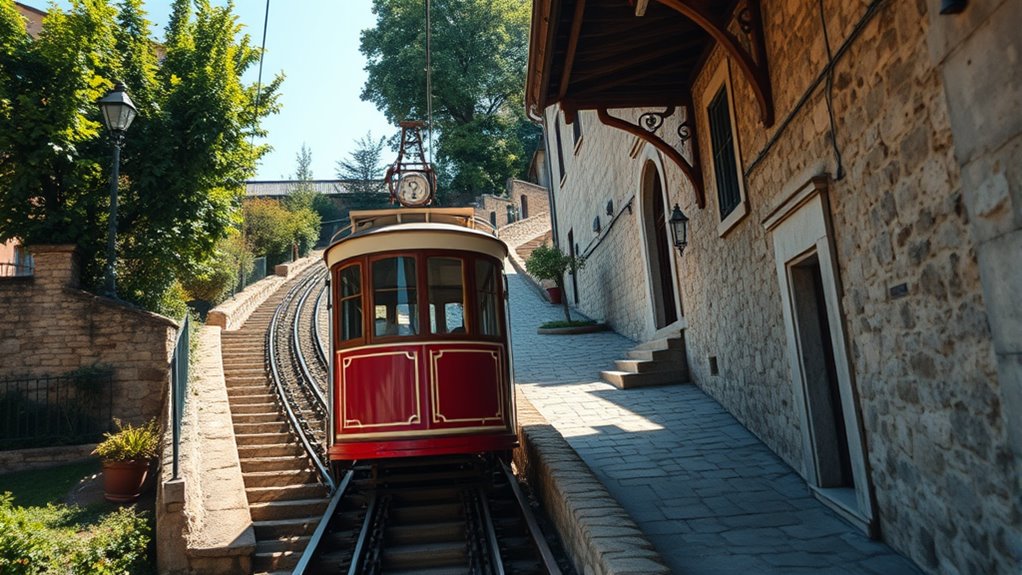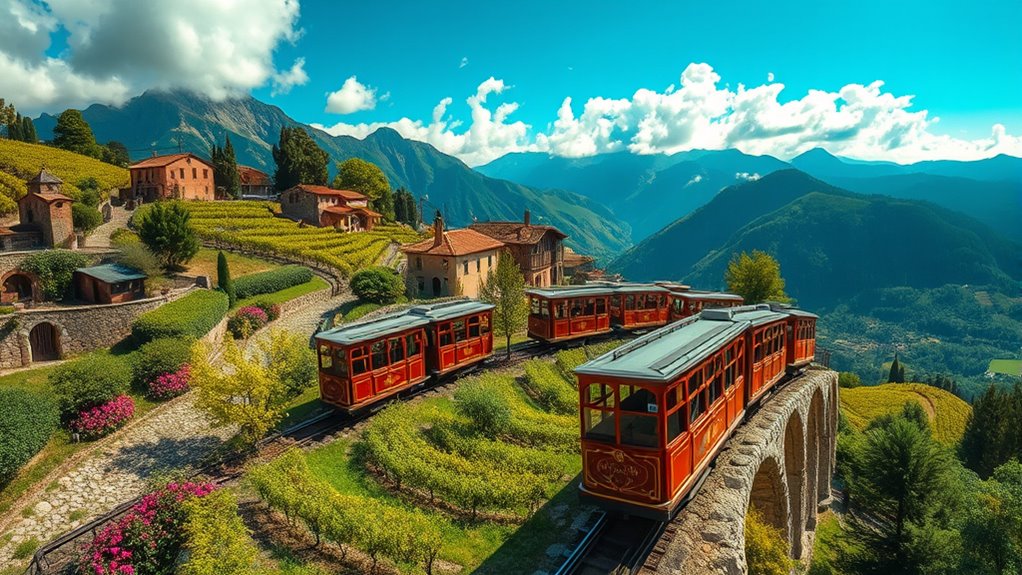Italian funicular railways have a rich history of engineering innovation to tackle the country’s steep and rugged terrains. Starting with simple counterweights and basic cable systems, they evolved into modern, sophisticated networks with advanced safety, computerized controls, and energy-efficient technologies. These systems are crucial in cities like Genoa, Milan, and Naples, serving both transportation needs and tourism. To discover how these iconic railways continue to blend tradition with modern progress, explore further.
Key Takeaways
- Italian funiculars originated in the 19th century with simple cable and counterweight systems.
- Early designs evolved to navigate Italy’s rugged and steep terrains efficiently.
- Modern systems incorporate advanced braking, computerized controls, and energy-efficient technologies.
- They became vital urban transit solutions in cities like Genoa, Milan, and Naples.
- Today, Italian funiculars are both functional transportation and cultural icons, blending tradition with innovation.

Italy’s steep terrain and historic cities have made funicular railways an essential part of its transportation network. These inclined transit systems have evolved over time, driven by engineering innovations that allowed them to navigate Italy’s rugged landscape efficiently. As you explore cities like Genoa, Milan, and Naples, you’ll notice how these railways are not just practical solutions but also symbols of technological progress. The early designs relied on simple counterweights and basic cable systems, but as engineering techniques advanced, so did the safety, speed, and capacity of these transports. Today, modern funiculars incorporate sophisticated braking systems, computerized controls, and energy-efficient technologies, making them a marvel of engineering innovation that seamlessly blend form and function.
Italian funiculars combine engineering innovation with scenic charm, transforming steep urban terrain into accessible, picturesque journeys.
Your journey on Italian funiculars also highlights their role in tourism development. These railways have become iconic attractions, offering scenic views and unique experiences that draw visitors from around the world. For many travelers, riding a funicular isn’t just about reaching a destination; it’s about immersing yourself in the local culture and history. For instance, the historic funiculars in Como and Turin connect you to picturesque neighborhoods and historic sites, enriching your travel experience. By making steep hills accessible, they open up areas that might otherwise be difficult to explore on foot, encouraging tourism growth in those districts. This accessibility has helped boost local economies, supporting small businesses, cafes, and shops along the routes.
Furthermore, the integration of funiculars into urban development plans has transformed cityscapes, making them more livable and accessible. When you ride these systems, you witness how they facilitate the movement of residents and tourists alike, reducing congestion and pollution. The development of new routes and modernization projects in recent decades underscore Italy’s commitment to maintaining these systems as essential infrastructure. They’re not just relics of the past but ongoing innovations that adapt to contemporary needs. As you experience Italian cities from a different perspective — ascending steep streets or reaching panoramic viewpoints — you see firsthand how engineering innovations and tourism development are intertwined in shaping Italy’s urban landscape.
In essence, Italian funicular railways stand as a tribute to creative engineering and strategic urban planning. They serve as functional transit solutions while also enhancing tourism appeal. Whether you’re marveling at their technical sophistication or enjoying breathtaking vistas, these railways embody Italy’s ability to combine tradition with innovation, ensuring that both locals and visitors benefit from their continued evolution.
Frequently Asked Questions
What Are the Main Technological Innovations in Italian Funiculars?
You’ll find that Italian funiculars feature key technological innovations like cable traction systems, which provide efficient and reliable movement uphill and downhill. Safety systems have also advanced considerably, incorporating automatic brakes and sensors to guarantee passenger safety. These innovations make Italian funiculars safer and more efficient, allowing you to enjoy scenic rides with peace of mind. Modern technology continually improves these systems, maintaining Italy’s reputation for innovative mountain transportation.
How Do Italian Funiculars Compare to Those in Neighboring Countries?
You compare Italian funiculars to those in neighboring countries by examining comparison standards like safety, efficiency, and design, recognizing regional variations. Italian funiculars often feature modern technology, scenic routes, and historical charm, setting them apart. In contrast, neighboring countries may emphasize different standards, like urban integration or innovative engineering. Overall, your assessment highlights regional influences shaping each country’s funicular systems, making each unique yet comparable.
What Are the Environmental Impacts of Italian Funicular Railways?
You might find that Italian funicular railways offer ecological benefits by reducing overall energy consumption compared to car travel, helping lower emissions. These systems are often powered by electricity, which can be sourced from renewable energy, further decreasing environmental impacts. By using funiculars, you contribute to a more sustainable transportation option that minimizes habitat disruption and reduces air pollution, making them an eco-friendly way to navigate steep terrains.
Are There Any Unique Cultural Influences on Italian Funicular Design?
You’ll notice that Italian funiculars often reflect regional architecture, blending into local landscapes with ornate designs or simple elegance. Cultural influences like culinary traditions also inspire vibrant color schemes and decorative elements, showcasing Italy’s rich heritage. These unique touches make each funicular a reflection of its area’s character, elevating more than just transportation but also celebrating local identity and craftsmanship in every detail.
How Have Italian Funiculars Adapted to Modern Transportation Needs?
You see, Italian funiculars have evolved by balancing heritage preservation with modern needs. They’re upgraded with new technology to guarantee safety and efficiency, making them essential for daily commuters and tourists alike. These adaptations help develop tourism, showcasing Italy’s scenic landscapes, while preserving their historic charm. You can enjoy a seamless ride that respects tradition yet meets contemporary transportation standards, blending Italy’s rich past with its dynamic future.
Conclusion
As you explore Italy’s funicular history, you’ll see it’s like a timeless thread weaving through mountains and cities. These railways have carried stories of innovation and adventure, connecting people to breathtaking views and hidden gems. Just as a well-tuned orchestra creates harmony, Italy’s funiculars blend engineering prowess with scenic beauty. They’re not just transportation; they’re living monuments echoing a rich past, inviting you to ride through history on a cable car that’s as lively as the country itself.









